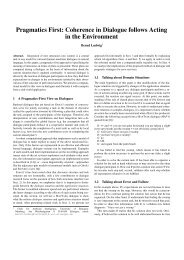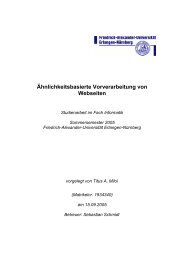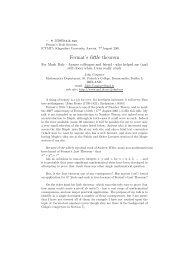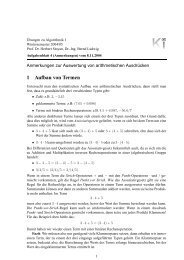Managing the Digitisation of Library, Archive and Museum Materials
Managing the Digitisation of Library, Archive and Museum Materials
Managing the Digitisation of Library, Archive and Museum Materials
You also want an ePaper? Increase the reach of your titles
YUMPU automatically turns print PDFs into web optimized ePapers that Google loves.
i.e. whe<strong>the</strong>r it meets <strong>the</strong> benchmarks defined in <strong>the</strong> feasibility study, such<br />
as colour representation, spatial resolution, <strong>and</strong> bit depth.<br />
■ Metadata. The metadata that is created <strong>and</strong> managed through a database<br />
will be subject to quality st<strong>and</strong>ards <strong>and</strong> must be factually accurate <strong>and</strong> spelled<br />
correctly. A controlled language, such as a <strong>the</strong>saurus, may be used to ensure<br />
that metadata is correct. The use <strong>of</strong> an authority list will limit spelling mistakes<br />
during data entry. The project must ensure that adequate metadata is provided<br />
to aid <strong>the</strong> finding <strong>of</strong> image resources.<br />
■ Types <strong>of</strong> Metadata. Various classes <strong>of</strong> metadata have to be recorded during<br />
a digitisation project. These include: descriptive, administrative <strong>and</strong> technical,<br />
structural, <strong>and</strong> preservation metadata. Descriptive metadata describes <strong>the</strong><br />
image so that <strong>the</strong> user can search <strong>and</strong> retrieve <strong>the</strong> item. Administrative <strong>and</strong><br />
technical metadata is recorded at <strong>the</strong> time <strong>of</strong> digitisation e.g. copyright<br />
information, date <strong>of</strong> digitisation, equipment used, name <strong>of</strong> scanning operator,<br />
image specifications, <strong>and</strong> <strong>the</strong> settings <strong>of</strong> <strong>the</strong> scanner. Structural metadata<br />
describes <strong>the</strong> internal structure <strong>of</strong> an item in <strong>the</strong> collection, e.g. <strong>the</strong> links<br />
between <strong>the</strong> images <strong>of</strong> <strong>the</strong> individual pages <strong>of</strong> a book. Preservation metadata<br />
provides information to ensure <strong>the</strong> preservation <strong>of</strong> <strong>the</strong> digital object. The four<br />
broad classes <strong>of</strong> preservation metadata are reference, context, provenance<br />
<strong>and</strong> fixity.<br />
Planning <strong>the</strong> digitisation project<br />
A successful digitisation project is one where <strong>the</strong> images are created <strong>and</strong><br />
delivered within <strong>the</strong> budget <strong>and</strong> deadline. Strategic planning is <strong>the</strong> key to a<br />
successful project, <strong>and</strong> must take into account all <strong>of</strong> <strong>the</strong> issues included in <strong>the</strong><br />
framework on page 6.<br />
The project plan should ideally be written by <strong>the</strong> project manager, <strong>and</strong> must<br />
be approved by all stakeholders. It is likely that <strong>the</strong> plan will be revised several<br />
times before all parties are satisfied that all key tasks, sub-projects, milestones<br />
<strong>and</strong> deliverables are documented <strong>and</strong> given realistic time scales. The project<br />
plan is <strong>the</strong> project manager’s authorisation to manage <strong>and</strong> control <strong>the</strong> execution<br />
<strong>of</strong> <strong>the</strong> project. The plan will be based on some previous definitions, such as:<br />
■ Aims <strong>and</strong> objectives <strong>of</strong> <strong>the</strong> project. These in turn depend on <strong>the</strong> institutional<br />
justification, i.e. <strong>the</strong> reasons <strong>the</strong> project is being undertaken.<br />
■ The scope <strong>of</strong> <strong>the</strong> project. This should be formulated explicitly after completion<br />
<strong>of</strong> <strong>the</strong> feasibility study, which will have spelled out what is included in <strong>the</strong><br />
digitisation project (<strong>and</strong> by default what is excluded), specifically, what materials<br />
are going to be digitised <strong>and</strong> to what technical st<strong>and</strong>ard. Any changes in <strong>the</strong><br />
project scope will affect <strong>the</strong> plan, <strong>and</strong> will entail changes to <strong>the</strong> plan. Such<br />
changes should be discussed with <strong>the</strong> stakeholders, <strong>and</strong> <strong>the</strong>ir approval sought,<br />
before any formal changes to <strong>the</strong> project plan are made. The reasons for <strong>the</strong><br />
change in <strong>the</strong> project scope should be fully documented, so that <strong>the</strong>y can be<br />
referred to later. This information should be made available to all <strong>the</strong> project<br />
staff <strong>and</strong> o<strong>the</strong>r interested parties.<br />
■ Risk analysis. A risk analysis exercise should be undertaken before <strong>the</strong> plan is<br />
constructed, in order to identify, characterise <strong>and</strong> document activities which could<br />
jeopardise <strong>the</strong> successful outcome <strong>of</strong> <strong>the</strong> project. The project manager will need to<br />
review <strong>the</strong>se risks throughout <strong>the</strong> project on a regular basis. Common risks include<br />
copyright problems, equipment failure, <strong>and</strong> shortages <strong>of</strong> technically skilled staff.<br />
The plan will include detailed consideration <strong>of</strong>:<br />
■ The st<strong>and</strong>ards to which <strong>the</strong> project will work.<br />
■ The resources that will be needed for each task to complete <strong>the</strong> project<br />
successfully. Before any work is undertaken, <strong>the</strong> project manager must assess<br />
accurately <strong>and</strong> realistically all necessary resources, including staff skills <strong>and</strong><br />
time, duration, space, <strong>and</strong> equipment.<br />
■ Sub-projects <strong>and</strong> <strong>the</strong>ir inter-relationship. Projects are usually divided into<br />
a number <strong>of</strong> sub-projects as more manageable components <strong>of</strong> <strong>the</strong> project.<br />
For example, <strong>the</strong> image capture or conversion process will be viewed as one<br />
sub-project. Some sub-projects may be dependent on o<strong>the</strong>rs having been<br />
completed first. Some may be undertaken by an external organisation, for<br />
example, digitisation may be undertaken by a digitisation bureau, or by<br />
ano<strong>the</strong>r department within <strong>the</strong> host institution.<br />
16<br />
17

















